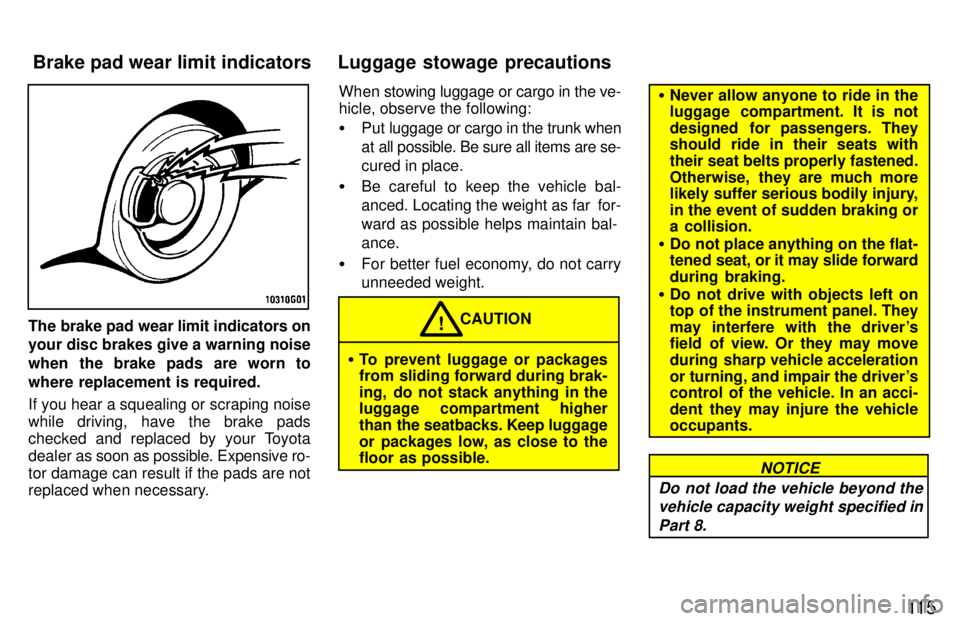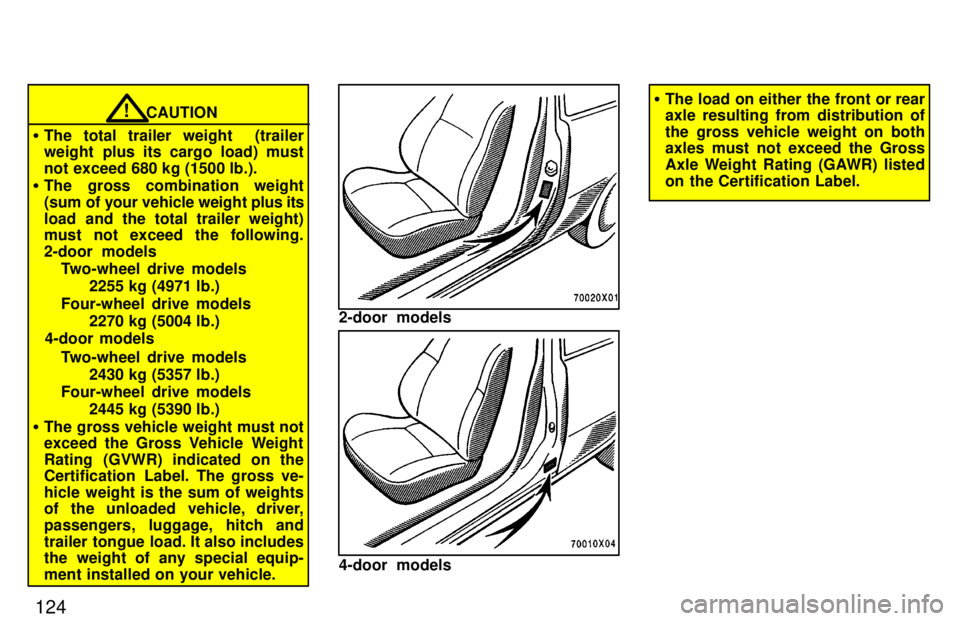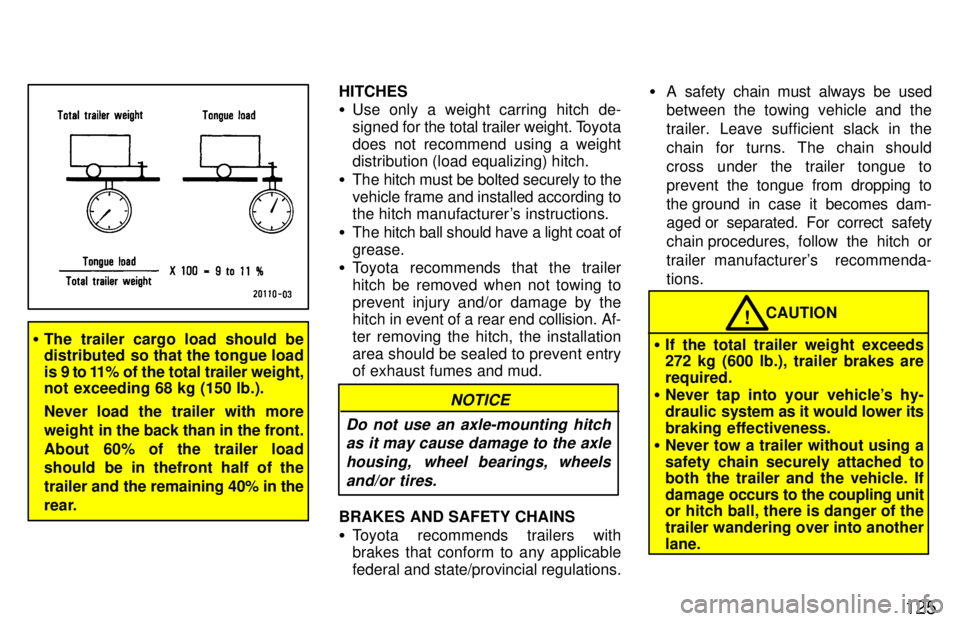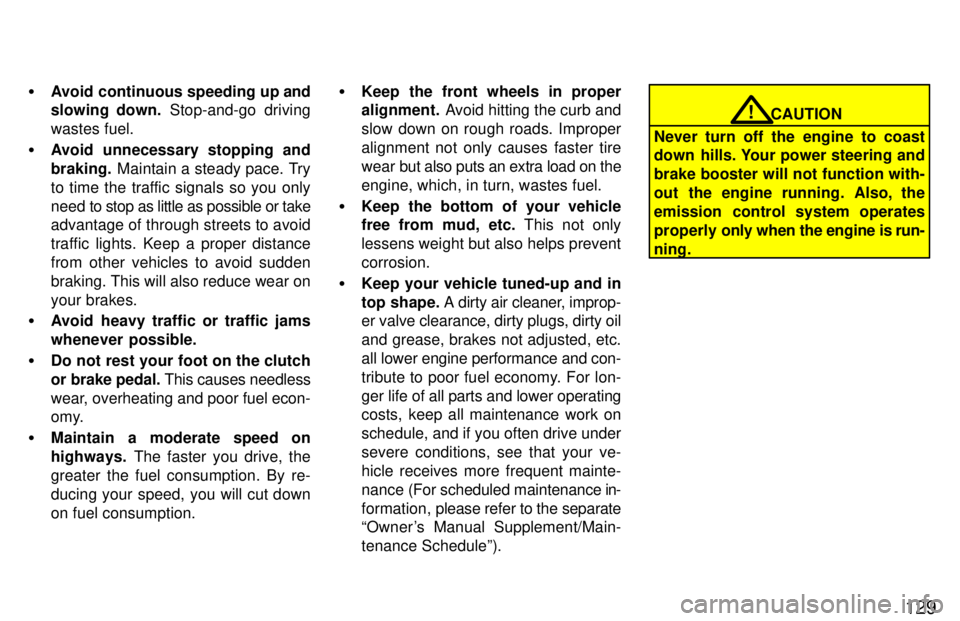1997 TOYOTA RAV4 weight
[x] Cancel search: weightPage 116 of 198

11 5
The brake pad wear limit indicators on your disc brakes give a warning noise
when the brake pads are worn to
where replacement is required.
If you hear a squealing or scraping noise
while driving, have the brake pads
checked and replaced by your Toyota
dealer as soon as possible. Expensive ro-
tor damage can result if the pads are not
replaced when necessary. When stowing luggage or cargo in the ve-
hicle, observe the following: �
Put luggage or cargo in the trunk when
at all possible. Be sure all items are se-cured in place.
� Be careful to keep the vehicle bal-
anced. Locating the weight as far for-
ward as possible helps maintain bal-ance.
� For better fuel economy, do not carry unneeded weight.CAUTION!
� To prevent luggage or packages
from sliding forward during brak-
ing, do not stack anything in the
luggage compartment higher
than the seatbacks. Keep luggage
or packages low, as close to the
floor as possible.
� Never allow anyone to ride in the
luggage compartment. It is not
designed for passengers. They
should ride in their seats with
their seat belts properly fastened.
Otherwise, they are much more
likely suffer serious bodily injury, in the event of sudden braking or a collision.
� Do not place anything on the flat-
tened seat, or it may slide forward
during braking.
� Do not drive with objects left on
top of the instrument panel. They
may interfere with the driver's
field of view. Or they may move
during sharp vehicle acceleration
or turning, and impair the driver's
control of the vehicle. In an acci-
dent they may injure the vehicle occupants.
Do not load the vehicle beyond the
vehicle capacity weight specified in
Part 8.
NOTICE
Brake pad wear limit indicators Luggage stowage precautions
Page 124 of 198

123
Use a washer fluid containing an anti-
freeze solution.
This product is available at your Toyota
dealer and most auto parts stores. Follow
the manufacturer's directions for how
much to mix with water.
Do not use engine antifreeze or any
other substitute because it may
damage your vehicle's paint.
NOTICE
Do not use your parking brake when there is a possibility it could freeze. When parking, put the transmission into
Pº (automatic) or into first or reverse
(manual) and block the rear wheels. Do
not use the parking brake, or snow or wa-
ter accumulated in and around the parking brake mechanism may freeze, making it
hard to release. Keep ice and snow from accumulating
under the fenders.
Ice and snow built up under your fenders
can make steering difficult. During bad winter driving, stop and check under the
fenders occasionally. Depending on where you are driving,
we recommend you carry some emer- gency equipment.
Some of the things you might put in the ve-
hicle are tire chains, window scraper, bag of sand or salt, flares, small shovel, jump- er cables, etc.
Your vehicle is designed primarily as a passenger-and-load-carrying vehicle.
Towing a trailer will have an adverse ef-fect on handling, performance, braking, durability and driving economy (fuel con-
sumption, etc.). Your safety and satis-faction depend on the proper use of cor- rect equipment and cautious driving habits. For your safety and the safety ofothers, you must not overload your ve-
hicle or trailer. Ask your local Toyota dealer for further details before towing. WEIGHT LIMITS
Before towing, make sure the total
trailer weight, gross combination
weight, gross vehicle weight, grossaxle weight and trailer tongue load are
all within the limits.
The total trailer weight and tongue load
can be measured with platform scales
found at a highway weighing station,
building supply company, trucking com-
pany, junk yard, etc.
Trailer towing
Page 125 of 198

124
CAUTION!
� The total trailer weight (trailer
weight plus its cargo load) must
not exceed 680 kg (1500 lb.).
� The gross combination weight
(sum of your vehicle weight plus its
load and the total trailer weight)
must not exceed the following.
2-door models
Two-wheel drive models
2255 kg (4971 lb.)
Four-wheel drive models 2270 kg (5004 lb.)
4-door models
Two-wheel drive models2430 kg (5357 lb.)
Four-wheel drive models 2445 kg (5390 lb.)
� The gross vehicle weight must not
exceed the Gross Vehicle Weight
Rating (GVWR) indicated on the
Certification Label. The gross ve-
hicle weight is the sum of weights
of the unloaded vehicle, driver,
passengers, luggage, hitch and
trailer tongue load. It also includes
the weight of any special equip-
ment installed on your vehicle.
2-door models
4-door models
�The load on either the front or rear axle resulting from distribution of
the gross vehicle weight on both axles must not exceed the Gross
Axle Weight Rating (GAWR) listed
on the Certification Label.
Page 126 of 198

125
�The trailer cargo load should be
distributed so that the tongue load
is 9 to 11% of the total trailer weight,
not exceeding 68 kg (150 lb.).
Never load the trailer with more
weight in the back than in the front.
About 60% of the trailer load
should be in thefront half of the
trailer and the remaining 40% in the
rear. HITCHES �
Use only a weight carring hitch de-
signed for the total trailer weight. T oyota
does not recommend using a weight
distribution (load equalizing) hitch.
� The hitch must be bolted securely to the vehicle frame and installed according to
the hitch manufacturer's instructions.
� The hitch ball should have a light coat of grease.
� Toyota recommends that the trailer
hitch be removed when not towing toprevent injury and/or damage by the
hitch in event of a rear end collision. Af-
ter removing the hitch, the installation
area should be sealed to prevent entry of exhaust fumes and mud.
NOTICE
Do not use an axle-mounting hitch as it may cause damage to the axle
housing, wheel bearings, wheels and/or tires.
BRAKES AND SAFETY CHAINS � Toyota recommends trailers with brakes that conform to any applicable
federal and state/provincial regulations. �
A safety chain must always be used
between the towing vehicle and the
trailer. Leave sufficient slack in the
chain for turns. The chain should
cross under the trailer tongue toprevent the tongue from dropping to
the ground in case it becomes dam-
aged or separated. For correct safety
chain procedures, follow the hitch or
trailer manufacturer's recommenda-tions.
CAUTION!
� If the total trailer weight exceeds
272 kg (600 lb.), trailer brakes are required.
� Never tap into your vehicle's hy-
draulic system as it would lower its
braking effectiveness.
� Never tow a trailer without using a
safety chain securely attached to
both the trailer and the vehicle. If
damage occurs to the coupling unit
or hitch ball, there is danger of the
trailer wandering over into anotherlane.
Page 127 of 198

126
TIRES �
Ensure that your vehicle's tires are
properly inflated. See Chapter 7-2 forinstructions.
� The trailer tires should be inflated to
the pressure recommended by the
trailer manufacturer in respect to the
total trailer weight.
TRAILER LIGHTS � Trailer lights must comply with federal,
state/provincial and local regulations. See your local recreational vehicle
dealer or rental agency for the correcttype of wiring and relays for your trail-
er. Check for correct operation of the
turn signals and stop lights each time
you hitch up. Direct splicing may dam-
age your vehicle's electrical system
and cause a malfunction of your lights.
BREAK-IN SCHEDULE � Toyota recommends that you do not
tow a trailer with a new vehicle or a ve-
hicle with any new power train compo-
nent (engine, transmission, differen-tial, wheel bearing, etc.) for the first
800 km (500 miles) of driving. MAINTENANCE �
If you tow a trailer, your vehicle will re-
quire more frequent maintenance due
to the additional load. For this informa-
tion, please refer to the scheduled
maintenance information in the Own-
er 's Manual Supplement/Maintenance Scheduleº.
� Retighten all fixing bolts of the towing
ball and bracket after approximately
1000 km (600 miles) of trailer driving.
PRE-T OWING SAFETY CHECK � Check that your vehicle remains level
when a loaded or unloaded trailer is
hitched. Do not drive if the vehicle has
an abnormal nose-up or nose-down
condition, and check for improper
tongue load, overload, worn suspen-
sion or other possible causes.
� Make sure the trailer cargo is securely
loaded so that it cannot shift.
� Check that your rear view mirrors con-
form to any applicable federal, state/
provincial or local regulation. If not,
install the rear view mirrors required
for towing purpose. TRAILER TOWING TIPS
When towing a trailer, your vehicle will
handle differently than when not tow-ing. The three main causes of vehicle
trailer accidents are driver error, ex-
cessive speed and improper trailer
loading.
Keep these in mind when tow-
ing: � Before starting out, check operation of
the lights and all vehicle-trailer con-
nections. After driving a short dis-
tance, stop and recheck the lights and
connections. Before actually towing a
trailer, practice turning, stopping and
backing with a trailer in an area away
from traffic until you learn the feel.
� Because stopping distance may be in-
creased, vehicle-to-vehicle distance
should be increased when towing a
trailer. For each 16 km/h (10 mph) ofspeed, allow at least one vehicle and
trailer length between you and the ve-
hicle ahead. Avoid sudden braking as you may skid, resulting in jackknifing and loss of control This is especially
true on wet or slippery surfaces.
Page 129 of 198

128
When restarting out after parking on a slope:
1. With the transmission in Pº position
(automatic) or the clutch pedal de-
pressed (manual), start the engine.
(With an automatic transmission, be
sure to keep the brake pedal de- pressed.)
2. Shift into gear.
3. Release the parking brake (also foot brake on automatic transmission ve- hicles) and slowly pull or back away
from the wheels blocks. Stop and ap- ply your brakes.
4. Have someone retrieve the blocks.
CAUTION!
� Do not exceed 72 km/h (45 mph) or
the posted towing speed limit,
whichever is lower. Because insta- bility (swaying) of a towing vehicle
trailer combination usually in-
creases as the speed increases, ex-
ceeding 72 km/h (45 mph) maycause loss of control.
� Slow down and downshift before
descending steep or long down- hill grades. Do not make sudden downshifts.
� Avoid holding the pedal down
too long or too frequently. This
could cause the brakes to over-
heat and result in reduced brak-
ing efficiency. Getting
more kilometers/mileage from a li-
ter/gallon of fuel is easy-just take it easy.
It will help make your vehicle last longer,
too. Here are some specific tips on how to
save money on both fuel and repairs: � Keep your tires inflated at the cor- rect pressure. Underinflation causes
tire wear and wastes fuel. See Chapter
7-2 for instructions.
� Do not carry unneeded weight in
your vehicle. Excess weight puts a
heavier load on the engine, causing greater fuel consumption.
� Avoid lenghty warm-up idling.
Once the engine is running smoothly,
begin drivingÐbut gently. Remember,
however, that on cold winter days this
may take a little longer.
� Accelerate slowly and smoothly.
Avoid jackrabbit starts. Get into high
gear as quickly as possible.
� Avoid long engine idling. If you have
a long wait and you are not in traffic, it
is better to turn off the engine and start
again later.
� Avoid engine lug or overrevving.
Use a gear position suitable for the
road on which you are travelling.
How to save fuel and make
your vehicle last longer, too
Page 130 of 198

129
�
Avoid continuous speeding up and
slowing down. Stop-and-go driving
wastes fuel.
� Avoid unnecessary stopping and braking. Maintain a steady pace. Try
to time the traffic signals so you only
need to stop as little as possible or take
advantage of through streets to avoid
traffic lights. Keep a proper distance
from other vehicles to avoid suddenbraking. This will also reduce wear onyour brakes.
� Avoid heavy traffic or traffic jams
whenever possible.
� Do not rest your foot on the clutch
or brake pedal. This causes needless
wear, overheating and poor fuel econ-
omy.
� Maintain a moderate speed on highways. The faster you drive, the
greater the fuel consumption. By re-
ducing your speed, you will cut down
on fuel consumption. �
Keep the front wheels in proper alignment. Avoid hitting the curb and
slow down on rough roads. Improper
alignment not only causes faster tire
wear but also puts an extra load on the
engine, which, in turn, wastes fuel.
� Keep the bottom of your vehicle
free from mud, etc. This not only
lessens weight but also helps prevent corrosion.
� Keep your vehicle tuned-up and in
top shape. A dirty air cleaner, improp-
er valve clearance, dirty plugs, dirty oil
and grease, brakes not adjusted, etc.
all lower engine performance and con-
tribute to poor fuel economy. For lon-
ger life of all parts and lower operating
costs, keep all maintenance work on
schedule, and if you often drive undersevere conditions, see that your ve-
hicle receives more frequent mainte-
nance (For scheduled maintenance in-
formation, please refer to the separate
Owner 's Manual Supplement/Main-
tenance Scheduleº).
CAUTION!
Never turn off the engine to coast
down hills. Your power steering and
brake booster will not function with-
out the engine running. Also, the
emission control system operates
properly only when the engine is run-
ning.
Page 169 of 198

173
2-door models
4-door modelsKeep your tire pressures at the proper level.
The recommended cold tire pressures,
tire size and the vehicle capacity weight
are also given in Part 8. They are also on the tire pressure label shown.
You should check the tire pressures every two weeks, or at least once a month. And
do not forget the spare!
Incorrect tire pressure can reduce tire
life and make your vehicle less safe todrive.
Low tire pressure results in excessive
wear, poor handling, reduced fuel econo-
my, and the possibility of blowouts from
overheated tires. Also, low tire pressure
can cause poor sealing of the tread bead.
If the tire pressure is excessively low,
there is the possibility of wheel deforma- tion and/or tire separation.
High tire pressure produces a harsh ride,
handling problems, excessive wear at thecenter of the tire tread, and a greater
pos-
sibility of tire damage from road hazards.
If a tire frequently needs refilling, have it
checked by your Toyota dealer.
The following instructions for check-
ing tire pressure should be observed: �
The pressure should be checked
only when the tires are cold. If your
vehicle has been parked for at least 3 hours and has not been driven formore than 1.5 km or 1 mile since, you
will get an accurate cold tire pressurereading.
� Always use a tire pressure gauge.
The appearance of a tire can be mis-
leading. Besides, tire pressure that
are even just a few pounds off can de-
grade handling and ride.
� Take special care when adding air
to the compact spare tire. The
smaller tire size can gain pressure
very quickly. Add compressed air insmall quantities and check the pres- sure often until it reaches the specified
pressure.
� Do not bleed or reduce tire pres- sure after driving. It is normal for the
tire pressure to be higher after driving.
� Never exceed the vehicle capacity weight. The passenger and luggage
weight should be located so that the
vehicle is balanced.
Checking tire pressure